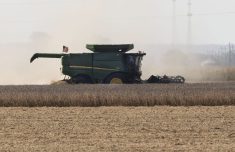Heated canola has become a problem for grain elevators and other buyers in Manitoba.
Several buyers reported, over the last week, that they received deliveries of heated canola, according to a Manitoba Canola Growers Association bulletin,
The MCGA said a number of factors may have contributed to an increased amount of heated canola this fall:
• A hot harvest in August.
• High moisture or high temperature at binning.
• Greed weed seeds and green canola seeds.
The growing popularity of straight combining canola may also be a factor.
Read Also

Trump mulls ending some trade ties with China, including in relation to cooking oil
U.S. President Donald Trump said on Tuesday Washington was considering terminating some trade ties with China, including in relation to cooking oil.
Joy Agnew, a grain drying expert at PAMI, formerly the Prairie Agricultural Machinery Institute, said straight combined canola might have a higher percentage of green seeds and could be more prone to heating in the bin.
It all comes down to variability of seed maturity, she said.
“You could have more green spots…. That’s going to (influence) the prevalence of hot spots in the bin. Green seeds have higher moisture content and they’re more likely to heat, or have the microbial respiration that causes heat and moisture.”
Chris Holzapfel, research manager with the Indian Head Agricultural Research Foundation, is skeptical that straight cut canola stores differently than swathed canola seed.
Damp canola is probably responsible for canola heating in Manitoba this fall, not straight combining. Holzapfel has conducted studies on straight cut canola and found little difference in the amount of green seed.
Straight cutting may increase the amount of green plant material in the bin, as green leaves, stems and pods may wind up in the combine hopper.
“I think that could, potentially, make the canola more susceptible to heating with straight combining,” Holzapfel said.
Growers who straight combine typically apply a pre-harvest aid or desiccant to the canola, which should mitigate the amount of green plant material.
Holzapfel isn’t convinced that straight cutting is worse than swathing for storing canola because storage problems are usually caused by adverse environmental conditions at harvest.
For instance, hot and dry weather following swathing can increase the percentage of green seeds in the canola. The swath can dry down very quickly and green seed can become “locked in,” he said.
The MCGA is advising growers to monitor bins for heating. Transferring the seed to another bin may be necessary. Producers should feel and smell the canola as it comes out of the bin, to detect signs of spoilage.
Contact robert.arnason@producer.com

















